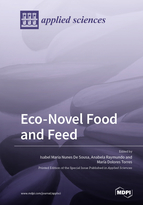Eco-Novel Food and Feed
A special issue of Applied Sciences (ISSN 2076-3417). This special issue belongs to the section "Applied Biosciences and Bioengineering".
Deadline for manuscript submissions: closed (30 November 2019) | Viewed by 30028
Special Issue Editors
Interests: characterization of the structure of food materials using Rheology and Texture complemented with microscopy; food product development; functional foods and new sustainable sources of food; foods for special groups e.g. celiacs and diabetics or special diets (low calories, high protein, etc.); design of food products to Industry, focused on nutritional and health claims, using under exploited food materials including food industry by-products within a bioeconomy reasoning
Special Issues, Collections and Topics in MDPI journals
Interests: rheology; proteins; emulsions; foams; gels; polysaccharides; 3D printing
Special Issues, Collections and Topics in MDPI journals
Interests: food rheology; functional foodstuff; gluten-free matrices; food product innovation with food by-products
Special Issues, Collections and Topics in MDPI journals
Special Issue Information
Dear Colleagues,
You are cordially invited to contribute to this Special Issue entitled “Eco-Novel Food and Feed”—a daring and trendy subject.
As we well know, innovation is recognized as the key driver of economic growth. Trends in the food industry deal with a permanent need to develop new food products, adjusted to the consumer demands and, in the near future, to scarcity of food resources. Concepts of sustainable food production and food products as health and wellness promoters, the use of alternative ingredients such as new protein sources, or the use of by-products in designed thought food or feed formulations according to bioeconomic principles, are current topics that act as driving forces for innovation. Currently, food or feed product development methodologies are generally based on the chemical and nutritional properties, complemented with a sensory validation, carried out in the final stages of the development process. In addition, the structure of food has proved to be a determinant for the food’s appeal, and strongly impacts consumers’ acceptance. It is well-known that products with the same chemical composition can present very different structures, resulting in differently perceived texture and sensory properties. In the creative process, the food macromolecules (proteins and polysaccharides) are the major players for the creation of relevant food structures such as foams, emulsions, and gels. The development of gluten-free or vegetarian products by using alternative proteins and polysaccharides, as well as the use of food industry by-products as sources of these structuring biopolymers, along with the structural implications of adding protein and/or fiber-rich healthy ingredients (e.g., macro or microalgae, psyllium) are some of the challenges in creating novel food or feed products. Sustainability in the production of the food ingredients and the economic viability of their production and subsequent transformation into well-accepted commercial food products are essential for the progress of the industry, with a relevant impact on the economy. Finally, the consumer attitude towards new food products is a relevant issue for the success of the novelties, and should be considered for close-to-market novel products.
These are some of the current topics, but you are welcome to add new ones and contribute to this highly impactful Special Issue.
Assoc. Prof. Isabel Maria Nunes de Sousa
Prof. Dr. Anabela Raymundo
Dr. María Dolores Torres Pérez
Guest Editors
Manuscript Submission Information
Manuscripts should be submitted online at www.mdpi.com by registering and logging in to this website. Once you are registered, click here to go to the submission form. Manuscripts can be submitted until the deadline. All submissions that pass pre-check are peer-reviewed. Accepted papers will be published continuously in the journal (as soon as accepted) and will be listed together on the special issue website. Research articles, review articles as well as short communications are invited. For planned papers, a title and short abstract (about 100 words) can be sent to the Editorial Office for announcement on this website.
Submitted manuscripts should not have been published previously, nor be under consideration for publication elsewhere (except conference proceedings papers). All manuscripts are thoroughly refereed through a single-blind peer-review process. A guide for authors and other relevant information for submission of manuscripts is available on the Instructions for Authors page. Applied Sciences is an international peer-reviewed open access semimonthly journal published by MDPI.
Please visit the Instructions for Authors page before submitting a manuscript. The Article Processing Charge (APC) for publication in this open access journal is 2400 CHF (Swiss Francs). Submitted papers should be well formatted and use good English. Authors may use MDPI's English editing service prior to publication or during author revisions.
Keywords
- innovation
- food/feed product development
- design thinking in food/feed formulations
- sustainability of food/feed
- food/feed as health and wellness promoters
- food for groups with special requirements
- food structure
- sustainability and economic viability
- re-introduction of by-products into the food value chain
- consumer acceptance and attitude
- market feasibility








